Hello Steemit, today I bring you the second part of my previous post. I want to show you the universe´s beauty, explaining in the best way, as humans have a cosmic origin. I hope you enjoy the post.
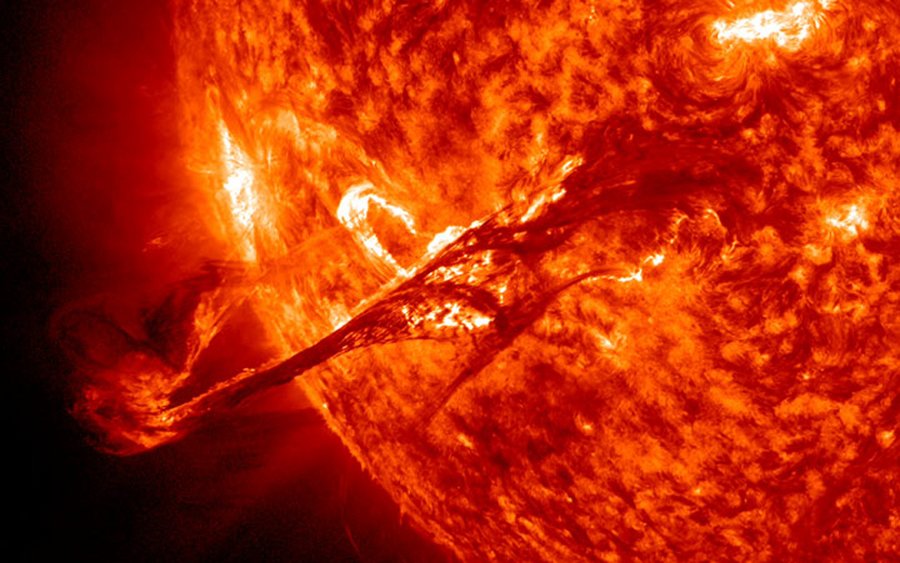
A newborn star is a star that has recently ignited hydrogen burning at its center. Searching the heavens, we can find many of these young stars scattered across space. They are easily identified because they are usually embedded in vast sweeping fragments of the cloud from which they emerged. Often, these gases shine with unprecedented beauty, as intense ultraviolet light from a young massive star causes the interstellar gases are fluorescent and glow. An example of these stars includes the famous Orion Nebula (Fig 1.).
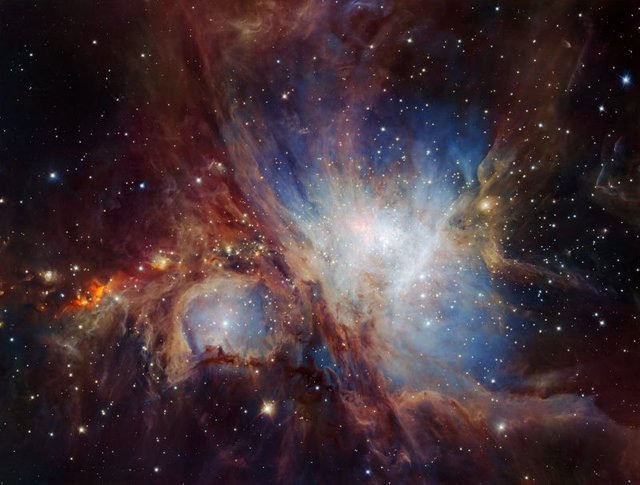
When you glance up at the sky, almost every star you see a young star still consuming hydrogen fuel at its core. Our star, the sun is a good example, having been born a mere 5 billion years ago. Six hundred million tons of hydrogen have been converted into helium for every second at the sun´s center. This may sound like a frightening rate, but the sun is in no danger of running out of hydrogen fuel. The mass of the sun is so huge that it has ample fuel to continue hydrogen burning for yet another 5 billion years more.
Although we usually speak of hydrogen “burning”, nothing is “burned” in the usual sense of a candle flame or logs in a fireplace. Instead, the thermonuclear reaction deep inside stars actually fuse the nuclei of atoms together. In these thermonuclear reactions, lighter elements are transformed into heavier elements at inconceivable temperatures and pressures.
Stars like the sun burn hydrogen at their cores for billions of years. Hydrogen is the fuel and helium is ash. But gradually, as these stars move from adolescence into adulthood, the amount of helium at their centers increases while the supply of hydrogen dwindles. And finally, at a crucial stage in the life of the stars, the time arrives when the hydrogen is depleted. This triggers major change in the structure and appearance of a stars, changes more profound and dramatic that none of these has known since its birth eons in the past.
Image one of these mature stars, like the sun, 5 billion years from now. As with all stars, it takes nearly a millions years for energy created at the star´s center to make its way laboriously to the star´s edge and to escape finally as starlight. Consequently, although significant changes are about to occur at the star´s core, you will not notice anything unusual for quite a while. There is still a million years’ worth of radiation climbing toward the star´s surface.
When all the hydrogen at a star´s center is used up, hydrogen burning shuts off. With no more outpouring of energy, the center of the star begins to become unstable, against the influence of gravity. Unable to support its own weight, the star´s helium-rich core begins to shrink. As this core becomes more and more compressed, temperatures deep inside the star rise to new heights. Although no more hydrogen remains at the start´s center, there is still plenty of fresh hydrogen fuel between the core and the surface. Finally, temperature surrounding the collapsing core rise high enough to ignite hydrogen burning in a thin shell around the nucleus.
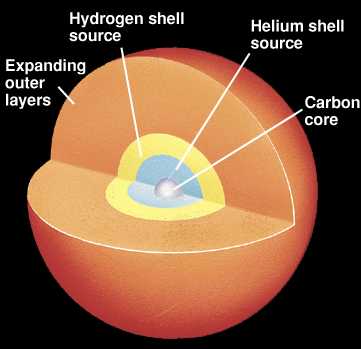
Observing this stellar metamorphosis from afar, you notice nothing unusual at first. But with the ignition of shell hydrogen burning, the star has found a new source of energy and fresh supply of fuel. Gradually, almost imperceptible at first, the star begins to swell. The start´s outer layers are slowly pushed outward as the star readjust to the continued contraction of its core, now surrounded by a thin shell of hydrogen burning.
The gravitational compression of the nucleus rich in helium, forces the temperature and pressure at the star´s center to unprecedented heights. Finally, at 100 million degrees, the helium nuclei at the star´s center are moving so fast that they collide violently that they fuse together to form carbon and oxygen. For the first time in the star´s history, a new thermonuclear reaction called helium burning makes its appearance.
The ignition of the burning of helium produces a new outpouring of energy that prevents the contraction of the nucleus. Now the stars have two thermonuclear reactions occurring inside them: burning the helium in the center surrounded by a shell of hydrogen burning. A dramatic response to this double barreled source of energy, the star swells to enormous proportions, increasing its volume a billionfold. As the outer layers of the star are pushed more and more outward, the atoms of which these layers composed get farther and farther apart. The density and pressure in the star´s layers decrease and in repose, so does the temperature. If you could look from a safe place, the bloated star´s surface has become big and cool.
The surface temperature of a star such as the sun is 6,000 degrees, and the white-hot gases shine with a dazzling white light. In the remote future when the sun expands to an enormous size, its surface temperature drop to 3,000 degrees. Instantly the white-hot, the cooler surface gases will then glow with a reddish hue, like the coals in a fireplace or a horseshoe in a blacksmith’s hearth. Stars of this type are called Red Giants (Fig 2.).
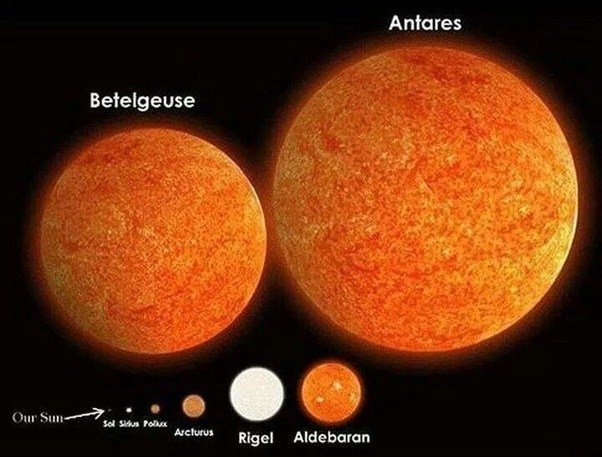
Five billion years from now, as our sun evolves into a red giant, the first planet to be vaporized will be mercury. As mercury will be consumed by the solar surface, Venus' thick carbon dioxide atmosphere will be swept away while earth´s oceans boil. Venus and Earth will soon have the same fate as mercury, the rocks will become gas, and at the end of the transformation the red giant will have a diameter of 200 million miles, a little larger than Earth's orbit. Even if our planet could survive, it would be inside in the swollen sun´s reddish atmosphere.
Almost every reddish star we see in the sky is a red giant, Aldebaran, Antares, Arcturus, and Betelgeuse, these are fine examples. All of them have hot, dense nuclei burning helium and hydrogen. All of them have enormous, wispy, bloated atmospheres glowing in shades of blood red.
Just as helium is the ash of hydrogen burning, oxygen and carbon are the ashes of the helium burning. And as we might expect after a few million years as a red giant all helium at the star´s center is used up. The burning of the helium will disappear and the nucleus of the star will once again become unstable and will begin to contract under the influence of the gravitational force. The temperature and pressure are driven higher than ever before, where the temperature will eventually reach enough to melt the star rich in carbon and oxygen, just as hydrogen burning disappears, helium will also disappear. At this stage the star has two thins shells of thermonuclear reactions: one where inert helium is burned and another hydrogen burning shell.
This is the last stage of the life of the stars like the sun. Stars like this do not have enough mass to ignite any further thermonuclear reaction. The weight of the star´s outer layers is not enough to force the temperature high enough to initiate carbon and oxygen burning. The carbon and oxygen in the core of this ancient sun remain inert as the hydrogen and helium burning shells creep outward, greedily searching for fresh fuel.
This configuration can´t be supported and the star begins to be unstable with slow pulsations. With each expansion the
star´s interior, the center of the star cools slowly, thus delaying the thermonuclear reactions. This decrease of energy output then permits the bloated start to contract and soon the extra compression rekindles the internal fires. This brief increase in energy output causes the star to expand and the cycle starts again.
Thousands of years elapse between each of the thermal pulses. Eventually the seizures become so great that the star´s outer layers separate completely from the burned-out core, these outer layers float gently into space, revealing a stellar corpse. When first exposed, the dead nucleus may have a temperature in excess of about 100,000 degrees and emits intense ultraviolet light. This radiation causes the expanding outer layers to fluorescence and glow with unprecedented beauty. The end result is called planetary nebula, surrounding the dead star like a cosmic funeral shroud.
The famous Ring Nebula (Fig. 3), is a fine example of a star that has ended his life. A star that dies can expel between a quarter and a half of its relative mass, in this relatively slow process produces a planetary nebula. Planetary nebulae have a phenomenal short life in the universe. After only 50,000 years, the expanding envelope of gases has become so thinly dispersed that the nebulosity disappears from view. Meanwhile, the dead star gradually shrinks in size as it radiates its warmth into space. Unable to ignite any further thermonuclear reaction, the star contracts until it is roughly the same size as the earth. The star has become a white dwarf.
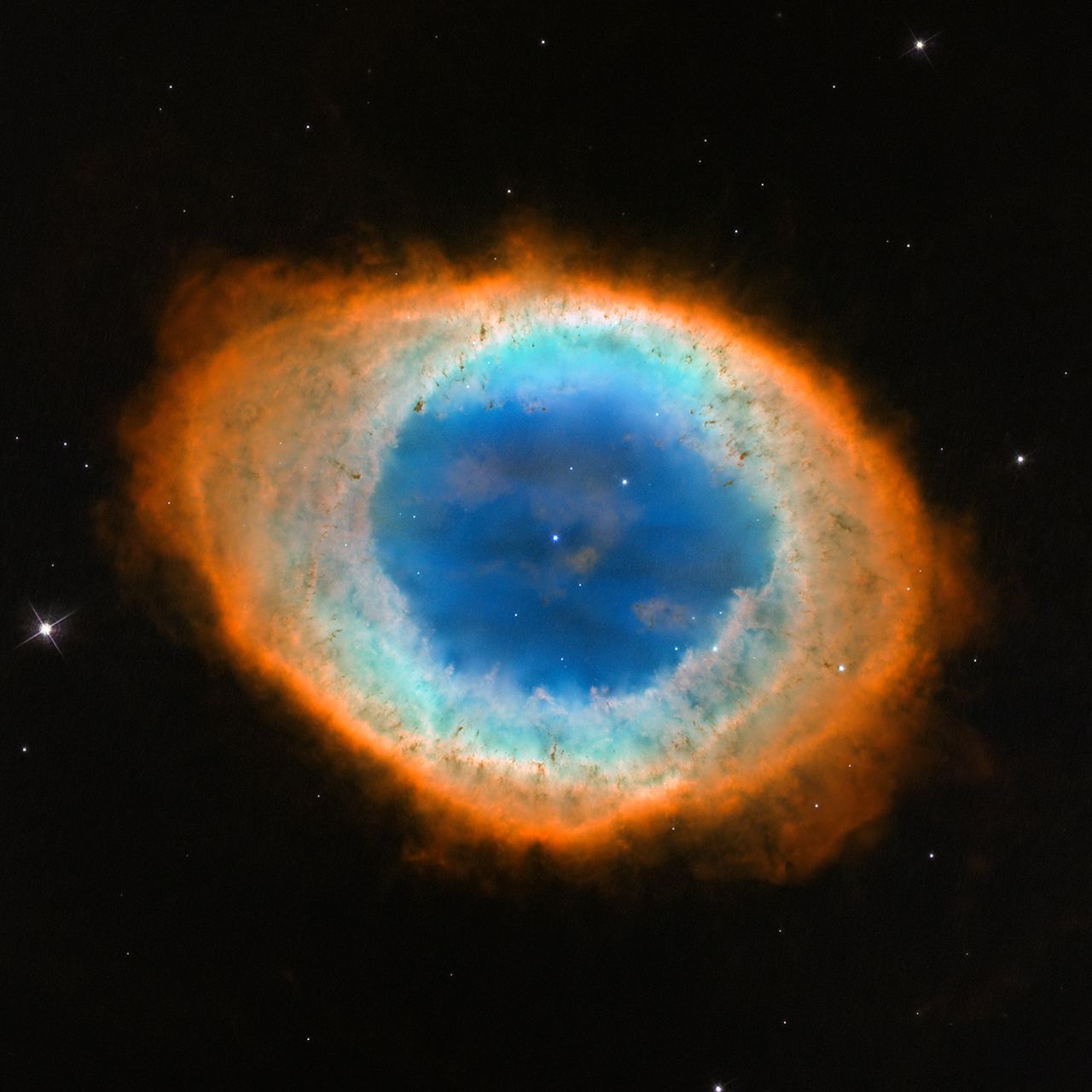
This should be the destination of our sun. Billions of years from now, not without having evaporated some planets, the outer layers of the sun will be expelled into space. For a brief moment about 50,000 years our solar system will be transformed into a beautiful planetary nebula as the layers of gas scattered in the dark.
This should be the destination of our sun. Billions of years from now, not without having evaporated some planets, the sun´s outer layers will be expelled into space. For a brief moment, a mere 50,000 years, our solar system will be transformed into a beautiful planetary nebula as the shells of gas rush outward toward the darkness. The sun´s burned-out core contracts and cools, begrudging release of its remaining warmth.
When the universe was created 20 billion years ago, only hydrogen and helium were formed. Only these two light elements could survive and emerge from the incredible and violent cosmic birth. But the world around us is composed of many heavy elements, there is hydrogen and oxygen in the air we breathe, calcium and potassium in our bones, and iron in our blood that flows in our veins.
These heavy elements were not a primary part of the fireball from which the universe was born. Neither were they created inside low-mass stars like the sun. Stars like our sun are incapable of creating elements heavier than carbon and oxygen. But deep inside massive stars fifty or sixty times bigger than our sun, an exotic selection of thermonuclear reactions can occur. Very late in the lives of these massive stars, the tremendous weight of star´s gases pressing inward from all side forces the central temperature billions of degrees. In this infernos, the heavier elements are forged.
The gentle creation of the planetary nebula is far too mild for the massive stars. Instead, they and their lives in nature´s most violent cataclysm: a supernova explosion (Fig 4.). For some days these stars increase their luminosity a thousand million times that they blast themselves apart. All the heavy elements that were created inside are then spewed across space.

The super-nova explosion enriches the interstellar medium with all the heavy elements. The new generation of stars to be born from this enriched material can be accompanied by the formation of planets, moons, asteroids and meteorites, as solid condensed elements from of nebulosity surrounding contracting proto-stars
This is what happened 5 billion years ago in the nebulosity that enveloped the proto sun. The universe was 15 billion years old at the time the sun was created. Many massive stars had already lived out their lives, so the solar nebula possessed an abundance of heavy elements. We therefore realize that every atom in our body, every atom we touch and breathe was created long ago deep inside a long-forgotten stars. We are literally made of the dust of stars.
If you like, uptvote and resteem. Follow me if you want to see more interesting articles.
Regards.
Congratulations @bape682!
Your post was mentioned in my hit parade in the following categories:
Downvoting a post can decrease pending rewards and make it less visible. Common reasons:
Submit
Awesome article! You should check out the game Everything. It has tons of awesome recording of lectures of Alan Watts . They relate tremendously with your post and the idea of our how relate to the universe. Even if you don't want to buy or play the game you can find playthroughs on YouTube and just skip to the recordings. One playthrough without player commentary can be found here
.
D̢͈̖̣̼̿͜ị͇̲͔̙̹̹ͧ͒̍́͐g̣͍͕̙̹̳̫̯̰̐i͌̈́ͥͫ̚͝͏͔̰͕̙̮͚̦̪t̡͔̱̭̱̦͙͔̭̃̆͛̑ͧͦ͡a̢̗̱̗͚̒̽̊̽̾͋̚̕͠l̷̬͎̔͜c̶̩̱̜̜̝̥͛ͮ̈̊́͘͢ő̡̰̟̳̯̼͑͆ͭ̌̑̂͠s̵͈͖͈͇̯͑͝m͈̬̤̪͎̑̾͛̉̍̔̕o͙̜̤͑ͫ̍͜s͓̯̯̰̱ͥ́̈̅̀͆͐̿͊ ̷̴͕̹̱͇̙̙͂̌̊ͭ͗͢w͖̲̩̓̉̈̋͞ͅa̷͔̲̼̟̟͈̲̹͗̿͂̈ͯ͗͜s̡̞̗͓͐̀ ͕̃ͭͬ͌̀̕͝h̴̴̢̪̮̜̅͆̆̓ͨe͙̹̝̗̱̺̝̗̼͊̉̓̕͟r̵̪̘̥͇̫͆ͬ̓̽̄ͭͮ̊ë̸̟̪͈̝̫͔̥̺́ͤ͠ͅ
.
Downvoting a post can decrease pending rewards and make it less visible. Common reasons:
Submit
it's mind boggling that we are literally formed from stardust! good read and keep on with your good work, i really appreciate scientific article! :)
Downvoting a post can decrease pending rewards and make it less visible. Common reasons:
Submit
Hey, great post! We have featured your article in our weekend newsletter! Keep up the good work, and let us know if you have any concerns.
Join us on the science-trail Discord
Downvoting a post can decrease pending rewards and make it less visible. Common reasons:
Submit
As Above, So Below..
As Without, so Within..
Downvoting a post can decrease pending rewards and make it less visible. Common reasons:
Submit
Followed and upvoted, This is great
RightWithin
Downvoting a post can decrease pending rewards and make it less visible. Common reasons:
Submit
You are a legend.... joined not long ago with a humble but growing following and absolutely smashing it with upvotes.... RESPECT ....
Downvoting a post can decrease pending rewards and make it less visible. Common reasons:
Submit
Wonderful, love to see this on steemit. Now i'm off to bed to dream of giant stars swallowing planets.
Downvoting a post can decrease pending rewards and make it less visible. Common reasons:
Submit
Interesting article. If you have seen this video from IBM long long time ago, it reveals something incredible to the point, however, it keeps more to science...
Ultimately showing what's out there far far in the distance/future is already hidden deep inside us...that's why the famous line - look within...
Great article...
Downvoting a post can decrease pending rewards and make it less visible. Common reasons:
Submit
I like the video that you have placed. It shows the complexity of the universe and shows humanity as part of a big cosmic system.
Downvoting a post can decrease pending rewards and make it less visible. Common reasons:
Submit
A lot to read
Downvoting a post can decrease pending rewards and make it less visible. Common reasons:
Submit
good article!! keep it up !
Downvoting a post can decrease pending rewards and make it less visible. Common reasons:
Submit
Rumi said: "the universe is inside you"
Downvoting a post can decrease pending rewards and make it less visible. Common reasons:
Submit
very niCe@bape682 please follow me and i can upvote you
Downvoting a post can decrease pending rewards and make it less visible. Common reasons:
Submit
The universe is always great and interesting! I followed you and look forward to the next article!
Downvoting a post can decrease pending rewards and make it less visible. Common reasons:
Submit
Congratulations @bape682! You have completed some achievement on Steemit and have been rewarded with new badge(s) :
Click on any badge to view your own Board of Honnor on SteemitBoard.
For more information about SteemitBoard, click here
If you no longer want to receive notifications, reply to this comment with the word
STOPBy upvoting this notification, you can help all Steemit users. Learn how here!
Downvoting a post can decrease pending rewards and make it less visible. Common reasons:
Submit
..... and now i realize that i gotta go for a pee. If i dont my life ends painful or ridiculously wet and i am in trouble.
Downvoting a post can decrease pending rewards and make it less visible. Common reasons:
Submit